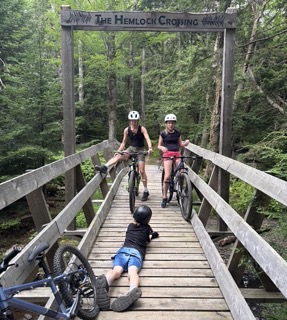
Summer is in full swing, and there’s no better time to get outside and enjoy the freedom of cycling! Whether you’re commuting through downtown Halifax, tackling long gravel rides, or hitting the trails with your kids (a new favourite for our very own Alison!), every ride should feel strong, smooth, and pain-free.
At Scotia Physiotherapy, our mission is to help you move better, prevent injury, and ride at your absolute best. Whether you’re new to cycling or training for your next race, our team is here to keep you rolling safely.
Common Cycling Injuries & How to Prevent Them
Here’s what you need to know to protect your body on the bike:
1. Neck, Upper & Lower Back Pain
Causes: Poor bike fit, weak core or back muscles, limited mobility, or previous injuries.
Prevention Tips:
- Get a professional bike fit (local shops like Long Alley and Cyclesmith offer great services)
- Strengthen your core and upper back
- Work on posture and flexibility
🎥 Watch Dawn Hanifen, PT, share simple posture tips to protect your neck while riding. (https://youtube.com/shorts/BZ2eDGXdDHA?feature=share)
2. Hand, Wrist & Arm Issues
Including handlebar palsy (ulnar nerve compression) and carpal tunnel syndrome.
Symptoms: Numbness, tingling, or weakness in the hands.
Prevention Tips:
- Vary hand positions often
- Keep wrists in a neutral position
- Relax your elbows
- Adjust handlebar and saddle setup
3. Knee & Leg Pain
Often caused by overuse or poor saddle height. Common conditions include:
- Patellofemoral Pain Syndrome
- Patellar Tendinopathy
- IT Band Syndrome
Prevention Tips:
- Ensure your knee has a 25–30° angle at full pedal extension
- Include strength training and soft tissue therapy
- Don’t ramp up mileage too fast
4. Foot & Ankle Problems
Think “hot foot,” Achilles tendinitis, plantar fasciitis, and tarsal tunnel syndrome.
Prevention Tips:
- Get properly fitted cycling shoes
- Stretch your calves and feet
- Have your biomechanics assessed if pain persists
5. Hip & Pelvic Pain
Including hip impingement, hamstring tightness, piriformis syndrome, and saddle sores.
Prevention Tips:
- Adjust saddle height (typically ~5cm peak, with 0–4° tilt)
- Activate your glutes before you ride
- Include mobility work in your routine
Ride Smarter with These General Tips:
✅ Get a Bike Fit Assessment – Align saddle, bars, and cleats to fit your body
✅ Incorporate Mobility & Strength Training – Cross-train to prevent overuse injuries
✅ Prioritize Rest & Recovery – Give your body time to heal and refuel
Local Cycling Tips for Halifax Riders
🚲 Commuting by Bike
Halifax is getting more bike-friendly—but potholes, weather, and traffic can be tricky.
👉 Tip: Review safety guidelines via the Halifax Cycling Coalition
🛤️ Road & Gravel Riding
Endurance rides challenge your posture and stamina.
👉 Tip: Add 1–2 strength sessions weekly to improve pedal efficiency and joint support.
🚵♀️ Mountain Biking with the Family
A fun and rugged way to stay active together—Alison’s new go-to when the ocean is flat!
👉 Tip: Warm up, use protective gear, and learn trail techniques before hitting the woods.
Check out Ride East for local mountain biking classes for all ages.
Book with Scotia Physiotherapy
At Scotia Physiotherapy, we support cyclists with:
✅ Physiotherapy, Massage Therapy & Osteopathy
✅ Nutritional Counselling for Energy & Recovery
✅ Personalized Exercise & Mobility Plans
📍Visit us at 6178 Quinpool Road, Halifax
🗓️ Book an Appointment Online
📞 Call Us: 902 425 3065
⭐️ Leave Us a Review
Let’s make this your strongest riding season yet. Whether you’re cruising the waterfront or prepping for your next trail challenge, we’ve got your back—literally.











